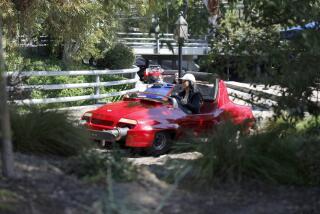There’s somethin’ fishy going on
THE crossroads of government regulation and car design has seen some nasty pileups. Please avert your eyes from the 1981 Fiat X 1/9, in the early days of 5-mph bumper regulations, which forced Bertone to bracket the edgy little car with moronic rubber parentheses. The current Pontiac Solstice is a lovely roadster unless and until you attach a front license plate — required by California law — on its bullet-smooth nose, after which the car looks like it has buckteeth and is pronounced “Pontiac Thol-sthith.”
No company has suffered more than Jaguar. In 1968, the U.S. Department of Transportation banned the use of glass-covered headlamps, which ruined the gorgeous glassine stare of the old E-type. By 1974, the Series III E-Type front end had been comically fitted with blocky, black-rubber Dagmars. For most of the next two decades, the company’s otherwise handsome cars (XJS, XJ6) were sandwiched between oversized chrome-and-rubber bumpers that looked like sterling-and-bakelite handles on a tea service.
FOR THE RECORD:
Jaguar review: A review of the 2007 Jaguar XK in Wednesday’s Highway 1 section mistakenly said that Ian Callum designed the Aston Martin DB9. Callum designed the DB7. Henrik Fisker designed the DB9. —
Which brings us, in a mood something like deep remorse, to the new, second-generation Jaguar XK, an absolutely stunning and stirring sports coupe/convertible design, an ensorceling work of animal appetite and biomechanical grace except, alas, for the first few inches — which look like hell. In order to comply with new European pedestrian-safety standards, Jaguar chief of styling Ian Callum was obliged to extend the nose of the car around the oval grille opening as well as lengthen the chin spoiler, so that the impact forces against a pedestrian’s legs are better distributed.
The result is all too familiar in a town where women are constantly running to their plastic surgeons for injections of collagen: tragic trout lips. The new Jaguar is the Meg Ryan of luxury GTs.
Here would be the place for an obligatory rant against the nanny state — or, in the case of the U.K., the Mary Poppins state — but the truth is, most car companies have little trouble coping with incrementally imposed safety regs. It is the peculiar curse of Jaguar, with its ethos of sleek, ellipsoidal design and preoccupation with heritage, that it should so often run afoul of such rules.
Still, I’m not willing to let Callum off the hook entirely. After all, this is the man who designed the Aston Martin DB9. There must have been a more elegant design solution than this, this gaping cakehole. It looks like a cross between a Ford Taurus and a blow-up novelty doll.
So what we have is, in fact, a nearly/not-quite perfect design, 99.44% pure; still, I reckon that’s quite enough to trump the XK’s most obvious rivals, the Maserati Coupe/Spyder and the BMW 6-series. The Jag is a powerful and masculine form, with tensed and back-loaded energy like an arm cocked to throw a punch. You might read other reviewers saying the sheet metal is pulled tight over the mechanicals. That’s wrong. The XK doesn’t have anything like the anorexic, see-the-ribs look of the DB9. This car has full, rounded volumes with only gentle creases along the rear haunches and along the beltline. It is, in other words, tumescent. If your XK lasts more than four hours, see your doctor.
This is only the second rendition of the XK (the “8” has been dropped from the nomenclature) since 1997. Although it is roughly the same length as the previous car, it is considerably wider over a wheelbase stretched more than a half-foot. These dimensions make the XK a more close-coupled car (with shorter front and rear overhangs) and set it deeper in its stance, brawny in a way the torpedo-like XK8 wasn’t. The car has some prodigious wheel wells that, alas, will undoubtedly host big, ugly aftermarket wheels. Up to 20-inch alloy rims are factory options.
Callum and the structural engineers emphasized the convertible design first with the hardtop designed afterward. But I must say, having driven both cars, the coupe is the more handsome design, and more livable — the wind noise on our convertible test car, top-up, gathered to a bothersome moan at “Vanishing Point” speeds.
On the other hand, because Jag went with a fabric top and not a bulky retractable hardtop, most of the 10 cubic feet of trunk space is preserved when the top is down (7.1 cubic feet). As for the coupe, I particularly like the way the rear backlight suggests the rear window on the classic XK-E. Pity the hatch isn’t hinged on the side.
P.S.: The coupe version of the classic E-type was always the prettier car, while the convertible appealed to oral surgeons and golf pros.
LIKE the current generation XJ sedan, the XK is an all-aluminum monocoque structure assembled from cast joints, extrusions and riveted panels in Castle Bromwich, the old Spitfire factory near Birmingham, England. This cash-intensive method of construction makes the car appreciably lighter (200 pounds in convertible form and nearly 400 pounds in coupe form) and vastly stiffer than the old steel-bodied XK8, which had tuning fork-like tremble when it hit big potholes or railroad tracks.
And, just as in the XJ, this aerospace-based technology is transforming. The previous XK was only willing to change direction. This car wants to. Light and handy and predictable, the XK — set up on its multiprocessor-powered adaptive suspension — now feels like a thoroughly modern GT, capable of big, carving corners and tail-waggling hairpin exits (until, of course, the stability control starts to selectively chatter the brakes). Body roll is negligible on all but the most flagrant maneuvers.
But this isn’t a toss-and-catch sports car — it’s too big and wide for that. This is a long-distance, low-altitude cruiser, with a light-oil lubricated, effortlessly centered feeling in the steering and a progressive, long-stroke touch in the brakes. Meanwhile, the adaptive suspension’s ride quality is terrific — stiff and tightly buttoned-down when the car is being driven hard (the computer knows), and Muzak-relaxed on interstate stretches. The chassis dynamics engineers have delivered a nearly perfect balance between grace and pace.
Beneath the long prow is Jaguar’s satin-smooth 4.2-liter, 300-hp V8, the same as in the XJ. But it certainly doesn’t sound the same. Jag’s powertrain engineers went to some lengths to imbue the XK’s exhaust note with a feline purr, which rises to a fervent, full-throated snarl as the engine builds rpm. It’s actually a little strange to have this perfectly balanced, super-clean powertrain (ULEV-II in California) cackle and snap like a Carolina moonshine runner.
To be sure, the best part of the powertrain is the six-speed ZF transmission with sequential paddle shifts. Left in “drive,” this tranny’s programming heavily emphasizes fuel economy, leaping to the tallest gear as soon as the driver lightens throttle pressure. This can make the car feel downright lazy unless you stomp the gas pedal. Slap the gearshift to the left-side gate, however, and suddenly the car wakes up, with the rpm held right in the meat of the torque curve.
Or you can use the paddle-shifters behind the steering wheel, which raises the car’s game (and redline) yet again. This is the quickest, smoothest manual-shifting automatic I’ve seen, rapping off double downshifts in a blink. In this market, 300 hp isn’t a lot of power, but this gearbox makes the most
of it. Zero to 60 mph for the coupe is 5.9 seconds, says Jaguar, and 6.0 seconds for the convertible.
By this time next year, we’ll have the more intense XKR version of the car, with bigger brakes, flintier suspension tuning, more reactive steering and 400 or so supercharged horses. Should be fun.
THERE is much to commend here. The Jag’s redesigned interior is properly upscale, with French-stitched leather upholstery everywhere and excellent trims of poplar, walnut or brushed alloy. Jaguar’s engineers have also come up with a unique nav/computer interface that might be the best on the market. According to the electronics guys, no adjustment is more than three steps away from the home screen.
In most respects, the Jag and the 6-series are close competitors; however, the Jag’s ease-of-use is light-years beyond the 6-series, saddled as it is with the confounding iDrive.
There are some minor faults with the car. The standard 160-watt stereo is pretty wimpy. Visibility is an issue (without the parking assist sensors you would probably wind up remodeling the car’s nose on your own). The things we put up with to look cool, eh? Otherwise, this is a terrific car.
These are not the best of times for Jaguar. The company is a perennial money-loser for its parent, Ford Motor Co., and it recently surrendered its spiritual home, the Brown’s Lane factory in Coventry. But the Jag XK shows no sign of cost-cutting compromise.
Actually, under the circumstances, the car seems heroic. Jag invested the millions it took to build an aluminum-bodied car, and from the exhaust note to its nav system gave the XK its own, distinctively British wit and invention.
It’s just too bad about the mouth, though. Maybe the swelling will go down?
*
2007 Jaguar XK Coupe/Convertible
Base price: $75,500/$81,500
Price, as tested: $81,300/$87,300
Powertrain: Naturally aspirated 4.2-liter, 32-valve, DOHC V8, with variable-valve timing and variable induction/exhaust geometry; six-speed ZF automatic with sequential paddle shift; rear wheel drive
Horsepower: 300 at 6,000 rpm
Torque: 310 at 4,100 rpm
Curb weight: 3,671/3,759 pounds
0-60 mph: 5.9/6.0 seconds
Wheelbase: 108.3 inches
Overall length: 188.6 inches
EPA fuel economy: 18 miles per gallon city/27 mpg highway
Final thoughts: Only the snout’s in doubt






